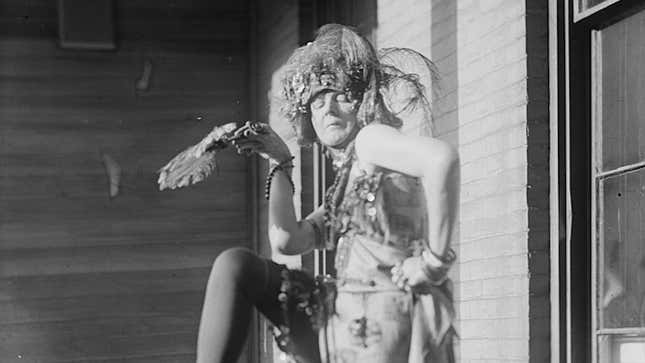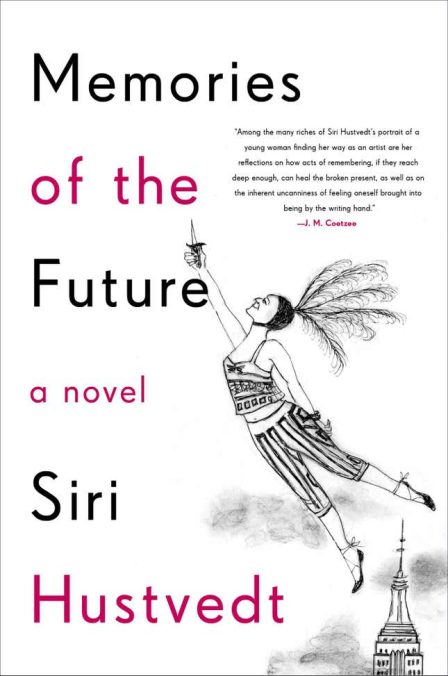

Siri Hustvedt’s seventh novel, Memories of the Future, contains several references to Baby Face, a 1933 film starring Barbara Stanwyck. Master of hardnosed wise-cracking, Stanwyck plays Lily Powers, a bored young woman working in her father’s bar. She is introduced to the philosopher Friedrich Nietzsche by an older patron, and a particularly memorable moment sees the young woman reading a paragraph from Will to Power which famously contains the phrase “Crush out all sentiment.” For Powers, it becomes a call to arms and signals her escape from her miserable situation, in which she is poor and constantly groped by her father’s clientele. She uses this hard-line thinking to scheme her way out of poverty, into comfortable housing, expensive jewels, and expansive furs. Though labeled a “hussy” by the high society she manages to enter, Stanwyck’s character remains, for the most part at least, focused on herself and her own happiness.
Though Hustvedt’s novel does not follow a plot that bears any resemblance to Baby Face, her inclusion of the film speaks to its interesting undercurrent: the ability of women to be, as the novel puts it “beastly and cold.” Of course, what it means for a woman to be either of those things is quite different from what it means for a man. In recent years, there have been several examples of difficult women who have graced our screens in their ambivalent glory, most recently the protagonists of Phoebe Waller-Bridge’s projects Killing Eve and Fleabag. Hustvedt seeks to depict women who are more complex than simple narrative devices and pull at the threads of memory that are colored by the often difficult emotions women feel under patriarchy.
Hustvedt explores rage, revenge, and violence in the lives of a group of women brought together through the city of New York. Memories of the Future is written through the perspective of S.H. as an older woman reflecting on a year of her life when she moved to New York from her native Minnesota. The young S.H., a clever, flexible thinker who’s in love with writing and with words (and also nicknamed “Minnesota”), has come to the city to write a novel before beginning a Ph.D. program at Columbia. In this year she has gifted herself, she goes on a quest through literature, looking for a story for her “unformed hero.” While the novel includes many of young S.H.’s diary entries—a form Hustvedt has used before—the older S.H. reflects not only on what is contained therein, or in the small excerpts of the novel-in-progress, but on memory itself, reflecting on what has been either omitted or included in the records of her younger self.

In the opening pages, Hustvedt considers the differences of years through the process of writing: “I didn’t know then what I know now: As I wrote, I was also being written.” The character of S.H., in both youth and older age, is clearly enamored with reading, and with novels: Hustvedt refers to a coterie of classic novels and novelists from Gustave Flaubert’s Madame Bovary, to George Eliot, the “peerless” Charles Dickens, and, the most clearly beloved Miguel de Cervantes’s Don Quixote. In the young S.H.’s search, there is something of Quixote about her, as she seeks to transform her visions from reality into the elevated plane of fantasy. The genre that particularly interests the young writer is the mystery, and throughout the novel, scenes from the mystery story she is writing weave in and out of her diaries. The older S.H., much more widely read and clearly supremely knowledgable, gradually comes to reflect on her earlier love of mystery, and particularly of Sherlock Holmes with whom she—and of course Hustvedt herself—share initials. The mystery, the clues, reading and interpreting signs, this way of approaching the world fascinates the young S. H. and dominates her thinking as she first makes her way in the city.
But through this reflection on clues and logic of the detective story, the narrator also considers the problem of the hero, or what she comes to refer to as the Standard Hero. In her definition, this narrative device has shaped the novel thus far, and delimited the possibility of who the hero of a story can be: the young S. H. is “stymied by a narrative that predates her existence.” And through this, Hustvedt returns to a theme that has been present throughout her writing life: the prioritizing of the male experience in art and the cultural position of the male genius.
Hustvedt returns to a theme that has been present throughout her writing life: the prioritizing of the male experience in art, and the cultural position of the male genius
In her 2014 novel The Blazing World, this exploration came in the form of pseudonyms, as her protagonist Harriet Burden, an artist sidelined and ignored throughout her career, decides to exhibit her work under the name of men to see the response of the art world. The success of these exhibitions is enthralling and horrifying to Burden, as she sees her ideas touted as the brilliance of a purely male mind, plowing the furrows of familiar thinking and repeating the mundanities of particular life experiences and discourses. Through S.H.’s experience in New York as a young woman seeking a hero, she begins to realize that her approach to fiction needs to be recalibrated to give more space to the experiences of women, heretofore undocumented.
Underpinning this idea is Hustvedt’s inclusion and clear admiration for Elsa von Freytag-Loringhoven, also known as The Baroness, an artist and writer whose name has been subsumed by more famous male Dadaists from the early 20th century. As in The Blazing World, which drew attention to the work of several women who had worked using male pseudonyms, as well as writer and philosopher Margaret Cavendish, Hustvedt writes Memories of the Future as a corrective for The Baroness’s legacy. Hustvedt laments the publication of The Baroness’s collected poetry several decades after her death and also discusses the origins of Marcel Duchamp’s The Fountain (1917), which some have suggested was the brainchild of both Duchamp and Freytag-Loringhoven. The Baroness, of course, has been completely erased from the history of The Fountain, as well as the readymade, even though she was one of the first artists to elevate a humble object to a work of art. For Hustvedt, this misattribution is yet another moment in which a woman has been sidelined to service the reputation of a male genius.
Hustvedt’s work has always sought to unpick the cultural mystique of the male genius and the allowances given for those hallowed brains. But Memories of the Future goes a step further in its critique, thinking about the way that the treatment of men has allowed them to get away with appalling behavior. She documents varieties of sexism and gendered violence, from casual street sexism to violent attacks and assaults. Her protagonist encounters many moments that now, as an older woman writing in 2017, she realizes are more sinister than she initially thought. Or indeed, in a new era of public attention to sexism and casual misogyny, the older S.H. now realizes that her tolerance of the behaviors of men reflects an upbringing in which she was expected to be polite and, above all, accommodating. Women were to keep men in check, not the other way around. Though the narrator’s documentation of these events is set in the past, she is not relegating them to a bygone era: with the narrative firmly in contemporary America, there is no false sense of progress. She is simply seeing with a new set of eyes.
The novel is particularly affecting when it describes the attempted rape of the young S.H. by a man she meets at a party. She chastises herself for her behavior, and examines her past for clues, marking out moments that produced what she sees as her cowardly reaction. But of course, as she continues to reprimand herself, she realizes that the problem was not her behavior, but in the assailant’s interpretation of it: “Over and over, I have wondered why he didn’t hear me, why he seemed to be a character in another story, and why his story smothered mine. Over and over I have spoken and not been heard. Over and over, I have been looked through.”
In young S. H.’s realization, she reveals the central problem of misogyny: it dehumanizes. One cannot make oneself seen. Her desire to unpack the events that led up to her attack does not begin and end with her, but are from a wider culture. This is not a mystery that can be solved: As older S.H. says later, “it can’t be reduced to true and false, to algorithms or even fuzzy logic. It’s not mathematics.”
One cannot make oneself seen
Much is made in recent years of authors who use their own life in their work, particularly with the creation of the term autofiction. And with several shared traits with her narrator, it would be tempting, and rather easy, to suggest that Hustvedt has indeed produced some form of it in this novel. But this would be to deny just how often many of the most canonical of writers also lifted details from their own lives: after all, Dickens used much of his experience in debtors’ prison for the plot of Little Dorrit and Flaubert famously proclaimed “Madame Bovary: c’est moi.”
Hustvedt has often used details of her own life in her writing. But to see this as anything other than fiction, and deeply involved in the production of the novel, would be to move away from one of the most central ideas of this novel overall. For Hustvedt, so much of memory is invention and embellishment. Fiction allows something memory does not: it’s fixed, and moves towards its end; the fluidity of memory means that “a memory is always in the present.” Hustvedt examines and plays with the tensions between the two, suggesting the interplay that renders fiction and memory inextricable.
Katie Da Cunha Lewin is a writer, researcher and teacher based in London. She has a PhD in the work of Don DeLillo and J.M. Coetzee from the University of Sussex. Her work can be seen in Hotel, The London Magazine, Times Literary Supplement, Irish Times, The White Review, and Los Angeles Review of Books, among other places. She wrote an entry for the Dictionary of Literary Biography on DeLillo and is the co-editor of Don DeLillo: Contemporary Critical Perspectives, published by Bloomsbury in 2018.